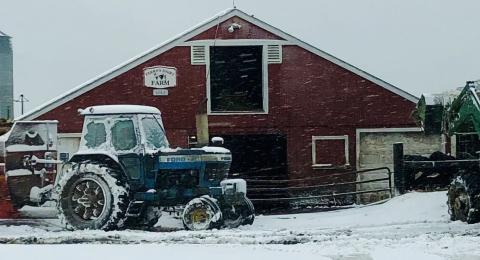This research was published in the INSPIRED: A Publication of the New Hampshire Agricultural Experiment Station (Summer/Fall 2023)
Researchers: A. Bruce, E. Neidecker, C. Zheng, I. Leslie and A. Wilhelm
A pressing concern for New England’s food system is the need to enhance local food production and establish resilient regional supply chains amid uncertainties posed by climate change and the COVID-19 pandemic. Achieving these goals hinges on the ability of farmers to increase food production. However, there is a lack of evidence-based understanding regarding the barriers and opportunities for farmers in this context. To address this knowledge gap, a comprehensive study was conducted to explore the strategies employed by New England farmers to make a living and sustain their farm businesses.
Farmers' Livelihood Strategies
The study conducted in-depth interviews between 2021 and 2022 with 37 New England farmers from diverse backgrounds and agricultural practices. Additional insights were gathered from 26 agricultural service providers and leaders of grassroots organizations closely working with farmers in the region. Employing a Sustainable Livelihoods Framework, various factors influencing farmers’ income-generation strategies were integrated into the research, considering both individual circumstances and the broader institutional and market context.
The findings reveal that a range of livelihood strategies are employed by New England farmers, combining resources such as off-farm jobs, agritourism and complementary enterprises supporting their farm businesses. Cooperative efforts and mutual aid also play a crucial role in filling gaps and ensuring sustainability. While a significant amount of time and labor are demanded by agricultural production, it only contributes a small portion to farmers’ overall livelihoods. Vital elements supporting New England farmers’ endeavors include inherited wealth, land and financial support from loans and grants.
Farm Viability
Traditionally, farm viability has been defined by the U.S. Department of Agriculture as meeting the income requirements of the farm family while covering operational costs. However, a different perspective is indicated by the interviews with New England farmers. For most farmers, farm viability is viewed as the ability to keep their operations running from year to year, rather than exclusively relying on the income generated—an important disparity between public interest in local food systems and the financial realities faced by farmers.
Key Findings

- It is financially impossible for most New England farmers to rely on producing food to earn a living.
- Revenue from agricultural production contributes a small portion of many farmers’ household income, despite requiring much of their time and labor. The food system incentivizes farmers to rely on non-production strategies, like agritourism, as well as off-farm sources of income, instead of farming full-time.
- Many New England farmers define “farm viability” as keeping the farm going from year to year and staying in business, rather than meeting the income needs of the farm family as the USDA defines it.
About the Co-Author

Analena Bruce, Assistant Professor, Agriculture, Nutrition and Food Systems
Contact information: Analena.Bruce@unh.edu

Many New England farmers must rely on agritourism and other methods to keep their operations viable.
The challenges faced by New England farmers in achieving farm viability and increasing food production are important to recognize. The complexity of the issue is attributed to financial constraints, the diversion of attention from food production and differing definitions of viability. To overcome these challenges, a multi-faceted approach is essential.
Collaborative efforts among stakeholders, policymakers and agricultural organizations are necessary to implement supportive policies, provide resources and foster partnerships, thus creating an enabling environment for farmers. These concerted actions can cultivate a more sustainable and resilient food system, ensuring that farmers can thrive and meet the growing demand for local, high-quality food in New England and beyond.
Related Published Research:
Loughrey, J., O’Donoghue, C., & Conneely, R. (2022). Alternative measures of family farm viability–Incorporating gap measures. Journal of Rural Studies, 89, 257-274.
